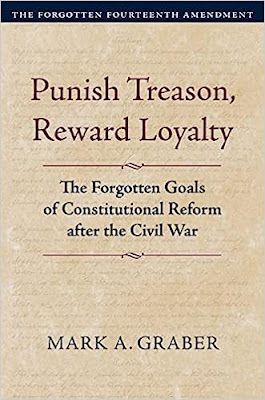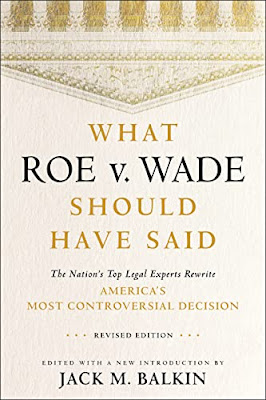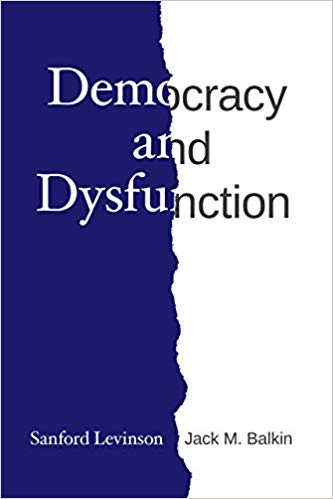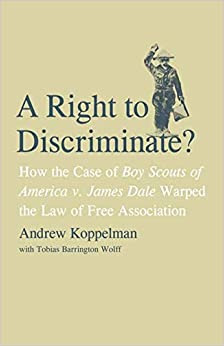Balkinization
an unanticipated consequence of
Jack M. Balkin
Balkinization Symposiums: A Continuing List
E-mail:
Jack Balkin:
jackbalkin at yahoo.com
Bruce Ackerman
bruce.ackerman at yale.edu
Ian Ayres
ian.ayres at yale.edu
Corey Brettschneider
corey_brettschneider at brown.edu
Mary Dudziak
mary.l.dudziak at emory.edu
Joey Fishkin
joey.fishkin at gmail.com
Heather Gerken heather.gerken at yale.edu
Abbe Gluck abbe.gluck at yale.edu
Mark Graber
mgraber at law.umaryland.edu
Stephen Griffin
sgriffin at tulane.edu
Jonathan Hafetz
jonathan.hafetz at shu.edu
Jeremy Kessler
jkessler at law.columbia.edu
Andrew Koppelman
akoppelman at law.northwestern.edu
Marty Lederman
msl46 at law.georgetown.edu
Sanford Levinson
slevinson at law.utexas.edu
David Luban
david.luban at gmail.com
Gerard Magliocca
gmaglioc at iupui.edu
Jason Mazzone
mazzonej at illinois.edu
Linda McClain
lmcclain at bu.edu
John Mikhail
mikhail at law.georgetown.edu
Frank Pasquale
pasquale.frank at gmail.com
Nate Persily
npersily at gmail.com
Michael Stokes Paulsen
michaelstokespaulsen at gmail.com
Deborah Pearlstein
dpearlst at yu.edu
Rick Pildes
rick.pildes at nyu.edu
David Pozen
dpozen at law.columbia.edu
Richard Primus
raprimus at umich.edu
K. Sabeel Rahmansabeel.rahman at brooklaw.edu
Alice Ristroph
alice.ristroph at shu.edu
Neil Siegel
siegel at law.duke.edu
David Super
david.super at law.georgetown.edu
Brian Tamanaha
btamanaha at wulaw.wustl.edu
Nelson Tebbe
nelson.tebbe at brooklaw.edu
Mark Tushnet
mtushnet at law.harvard.edu
Adam Winkler
winkler at ucla.edu
Compendium of posts on Hobby Lobby and related cases
The Anti-Torture Memos: Balkinization Posts on Torture, Interrogation, Detention, War Powers, and OLC
The Anti-Torture Memos (arranged by topic)
Recent Posts
Judge Posner Skewers Textualism-Originalism (Thomas, Scalia), And Reveals the Increasing Politicization of Judging by Conservatives
Just A Few Blogs
ACS Blog
Alas, a Blog
Althouse
Arts and Letters Daily
Atrios (Eschaton)
Bill of Health
Buzzflash.com
Buzz Machine
Cato at Liberty
Juan Cole (Informed Comment)
Concurring Opinions
The Constitution in 2020
Corrente
Crooked Timber
Daily Howler
Daily Kos
Dana Boyd
Brad DeLong
Digby (Hullabaloo)
Discriminations
Daniel Drezner
Kevin Drum (Mother Jones)
Electrolite
En Banc
Eunomia (Daniel Larison)
Fafblog
Michael Froomkin (Discourse.net)
GovLab (Beth Noveck)
Rick Hasen (Election Law)
History News Network
How Appealing
Ignatz (Sam Heldman)
The Importance of (Ernie Miller)
Infolaw
Instapundit
International Economic Law and Policy Blog
IntLawGrrls
Jacob Levy
Jesus' General
Jurisdynamics
The Kitchen Cabinet
Mark Kleiman
Law Blog Central
Larry Lessig
Lawyers, Guns and Money
Liberal Oasis
Brian Leiter's Law School Reports
The Leiter Reports
Marginal Revolution
Megan McArdle
Memeorandum
Metafilter
Mirror of Justice
The New Republic
Newseum
No More Mister Nice Blog
Brendan Nyhan
Opinio Juris
Orcinus
The Originalism Blog
Pandagon
Passport (Foreign Policy)
Overcoming Bias
Political Animal (Washington Monthly)
Political Theory Daily Review
Political Wire (Taegan Goddard)
The Poor Man
Virginia Postrel
Prawfsblawg
Public Reason
Jonathan Rauch
Raw Story
Redstate
ReligiousLeftLaw.com
Reporters Committee For Freedom of the Press
Reproductive Rights Blog
Rothman's Roadmap to the Right of Publicity
SCOTUS Blog
Seeing the Forest
Clay Shirky
The Shifted Librarian
The Situationist
Larry Solum (Legal Theory)
Andrew Sullivan
Talking Points Memo
Talk Left
Tapped
Tbogg
TechPresident
The Paper Chase (Jurist)
Tom Paine
Tom Tomorrow (This Modern World)
Eve Tushnet
Uggabugga
University of Chicago Law School Faculty Blog
Unqualified Offerings
The Volokh Conspiracy
War and Piece (Laura Rozen)
Wampum
Oliver Willis
Wonkette
Written Description
Matthew Yglesias
Yin
Your Choice of Feeds
1. XML
powered by
2. Atom Feed
3. RSS 2.0
Judge Posner Skewers Textualism-Originalism (Thomas, Scalia), And Reveals the Increasing Politicization of Judging by Conservatives
Brian Tamanaha
The following passage is from Judge Posner’s fascinating—that is, informative, insightful, provocative, sometimes strange, exercise in unadorned truth telling about judging (by his own lights)—How Judges Think:This politically conservative response (“originalism” or “textualism-originalism”)—which under different conditions could be a liberal response but is more congenial to conservatives because of its evocation of an era more culturally conservative than today—illustrates a more general tendency of judges to reach backward for the grounds of their decision. By doing so they can if challenged claim to be employing a different methodology that involves deriving conclusions from premises by logical operations as distinct from basing action on a comparison of the social or political consequences of different possible outcomes. But the backward orientation actually enlarges a judge’s legislative scope, and not only by concealing that he is legislating. A judge or Justice who is out of step with current precedents reaches back to some earlier body of case law (or constitutional text) that he can describe as the bedrock, the authentic Ur text that should guide decision. And the older the bedrock, the greater the scope for manipulation of meaning in the name of historical reconstruction or intellectual archeology….
The originalist’s pretense that [one can derive authoritative interpretations applicable to present disputes in this manner] makes originalism an example of bad faith in Sartre’s sense—bad faith as a denial of freedom to choose, and so the shirking of personal responsibility...[Justice Breyer also gets some criticism here].
Sartrean bad faith need not be conscious….He considers his decisions legitimate, concludes they must therefore be legalist, and constructs a legalist rationale that convinces him that his decision was not the product of his personal ideology.
Through a statistical comparison, Posner shows that conservative Justices on the current court more consistently vote in accordance with their political values than do liberal Justices (some of the numbers can be found here); and that the current generation of Republican appointed federal court of appeals judges shows a significantly higher proportion of conservative votes than Republican appointed judges over the past eighty years (Republican appointed federal appellate judges from 1925-2002 vote conservative 55.8% of the time; Republican appointed currently sitting judges vote conservative 66.9%); whereas there is no significant change in the conservative voting pattern (49.6%; 49.7%) of Democratic appointed judges between these two periods, and a reduction in their liberal votes (43.5%; 39.5%).
Put more simply: the Supreme Court Justices and Appellate Judges appointed by Presidents Reagan, Bush and Bush vote consistent with their political views at a higher rate than previous Republican appointees, and at a higher rate than Democratic appointees. That’s what the numbers show.
Posner explains this increased politicization in judicial votes as a consequence of the emphasis Republican Presidents since Reagan have placed on ideology (replacing mainly patronage considerations) in selecting judges for appointment. To explain the less robust political voting of Democratic appointees, he suggests (a bit strangely, although perhaps correctly) that Democrats don’t have their act together compared to Republicans in vetting judges for ideology, and he also suggests that perhaps liberal judges are less committed to fighting for their liberal values.
A simpler explanation might be that Democratic judicial appointees are more committed to respecting and abiding by the law (to restraining the influence of their political views).
Posted
12:08 PM
by Brian Tamanaha [link]
I'm ambivalent about Posner, but perhaps this book is worth a read.
It's "Ideological Voting on Federal Courts of Appeal" and is on SSRN (but of course) with co-authors Schkade and Ellman.
A relevant passage from the abstract:
"Taken as a whole, the evidence suggests that judges frequently issue collegial concurrences, that is, concurrences produced by the unanimous views of the other judges on the panel, and that judges are subject to group polarization, by which groups of like-minded people go to extremes."
Put more simply: the Supreme Court Justices and Appellate Judges appointed by Presidents Reagan, Bush and Bush vote consistent with their political views at a higher rate than previous Republican appointees, and at a higher rate than Democratic appointees. That’s what the numbers show.
Posner explains this increased politicization in judicial votes as a consequence of the emphasis Republican Presidents since Reagan have placed on ideology (replacing mainly patronage considerations) in selecting judges for appointment. To explain the less robust political voting of Democratic appointees, he suggests (a bit strangely, although perhaps correctly) that Democrats don’t have their act together compared to Republicans in vetting judges for ideology, and he also suggests that perhaps liberal judges are less committed to fighting for their liberal values.
A simpler explanation might be that Democratic judicial appointees are more committed to respecting and abiding by the law (to restraining the influence of their political views).
If Posner is positing that the politically conservative approach is original meaning and/or original intent of the law, then the politically liberal approach must be living constitutionalism - court rewriting of the law to adhere to "modern mores."
In this case, your observation that liberals are "more committed to respecting and abiding by the law" because they decline to consistently utilize liberal living constitutionalism implies that conservative originalism is more respectful and abiding by the law than liberal living constitutionalism. This textualist can hardly argue with that self evident proposition.
However, if originalism is more faithful to the law and the conservatives are more consistently faithful to originalism than are the liberals, then it would be a mistake to conclude that liberals are "more committed to respecting and abiding by the law."
Rather, I would suggest that the data indicates that that the text in some laws which are simply so clear that even liberals will decline to rewrite them even if that ruling results in a "conservative" result. However, because conservatives start with the text in their interpretation, they end up being more consistent in their outcomes.
There's also the fact that the only recent left presidency was quite centrist, in particular regarding things like crime (a pretty major issue in judicial appointments, I'd think).
No. He observed the material you quoted, and then you put a spurious causal explanation in his mouth.
What Sunstein et. al. found was that there was a distinctive difference in the 3-judge panels:
3 Republican president appointees on a panel voted much more ideologically than the panels consisting of a combination of 2 RPA's and 1 DPA. Whereas 3 Democrat president appointees did not vote to the same degree differently than when the panel had 2 DPA's and 1 RPA.
The presence of a dissenting (Sunstein calls them "whistleblower" judge) moderated the Republican panels as it did the Democrat panels, but when there was no dissenter the all-Republican panels deviated to more extreme ideological voting than did the all-Democrat panels.
Make of that what you will.
I tend to think of it as a "bad boys" syndrome. Immoderate behavior is emboldened by numbers and restrained by whistleblowing.
It's hard to make any predictions at all about Hillary these days, given that we don't know what persona she will be presenting on any given day. The populist anti-elitist we're currently seeing might well be opposed to judicial review at all, but one never knows a thing where the Clintons are concerned (beyond the almost literally incredible relentlessness in trying to maintain their top-dog status). I assume that Obama in fact has a far better conception of what he'd like to do in making appointments, but, of course, the morons who are in charge of "debates" and the news shows think such questions beneath them when it is so more interesting to take about flag lapel pins. But I digress....
"More particularly, a Democratic appointee, on a courts of appeal panel, turns out to be extremely important in ensuring that such a panel does what the law asks it to do."
Well, we've known that for 50 years at least.
I have a bit of trouble following your reasoning, so I don't know how to respond.
On the subject of "Originalism", my view is much like Posner's--it's a capacious theory of interpretation that allows judges much leeway for invention.
Setting that aside, you should look at the statistics on federal appellate judges. Two contrasts are telling: 1) that between Republican appointees and Democratic appointees; 2) that between current Republican appointees and Republican appointees over the past 80 years.
All of your arguments "explain away" the differences between Republican and Democratic appointess--flipping the higher political votes of the former into a greater degree of fealty to the law (nice work!). But let's set that aside.
Instead explain why current Republican appointees decide cases at a significantly higher conservative-politics rate compared to Republican appointees over the last 80 years. [and don't say the meaning of "conservative" has changed over time--Posner corrected for that].
Here you have two sets of Republican appointees, with the contemporary group apparently rendering decisions in a far more politically-infused manner. You can hardly say both are following the law equally, right?
Sandy,
You are right that the profile of Clinton's appointees was "moderate" rather than liberal. That probably explains the drop in liberal views of the current generation of judges.
As for the judicial appointees of President Hillary Clinton, my hope is that we will not find out.
Brian
So, Scalia can furrow his brow and say "I'm so sorry, but I can't rule that the constitution forbids the execution of the innocent" or some equally heinous and evil decision, claiming that he is totally constrained by originalism when in fact he diverts from it all the time and he really just doesn't have any sympathy for death row inmates claiming innocence that justifies (in his mind) a departure from originalism.
It seems to me Posner's got the originalists dead to rights on that.
I asked the same question to a conservative commenter on another website with respect to how one explains the difference between current Republican appointees and the preceding 75 years of Republican appointees. The argument was that Eisenhower was a liberal, Nixon screwed things up, and it wasn't until Reagan that things got "back on track."
So, they've got that going for them. Which is nice.
Yep: Ike was a liberal: he knew Nixon was a screw-up even before Nixon made it a public fact.
adgslpx
Pure ... ehhh, ummmm ... 'pragmatism'.
Forget about any principles, do what you need to do for the god of the country. That was his basic analysis. He was claiming that the decision, unfounded on law as it was, prevented some alleged political "constitutional crisis"....
Cheers,
I haven't read these studies, but I'm sure you've heard of the Four Horsemen, Lochner, Adkins v. Children's Hospital, Schechter... yet you really think Republican appointees then rendered decisions in a less politically infused manner than now? I think some of Eisenhower and Nixon's appointees were simply products of poor vetting. We know that Eisenhower always regretted putting Warren and Brennan on the Court.
But don't discount the impact of the median Senator. The ideology of the median Senator influences both the choice of nominees and the chances for approval. This means that judges appointed by liberal Presidents facing a more conservative Senate will form ideologically liberal opinions less often--since they will be less ideologicall liberal. The reverse is also true.
حلي الاوريو الفطر الهندي صور تورتة حلى قهوه طريقة عمل السينابون طريقة عمل بلح الشام بيتزا هت كيكة الزبادي حلا سهل صور كيك عجينة العشر دقائق طريقة عمل الدونات طريقة عمل البان كيك طريقة عمل الكنافة طريقة عمل البسبوسة طريقة عمل الكيك طريقة عمل عجينة البيتزا فوائد القرفه
Books by Balkinization Bloggers

Linda C. McClain and Aziza Ahmed, The Routledge Companion to Gender and COVID-19 (Routledge, 2024)

David Pozen, The Constitution of the War on Drugs (Oxford University Press, 2024)

Jack M. Balkin, Memory and Authority: The Uses of History in Constitutional Interpretation (Yale University Press, 2024)

Mark A. Graber, Punish Treason, Reward Loyalty: The Forgotten Goals of Constitutional Reform after the Civil War (University of Kansas Press, 2023)

Jack M. Balkin, What Roe v. Wade Should Have Said: The Nation's Top Legal Experts Rewrite America's Most Controversial Decision - Revised Edition (NYU Press, 2023)

Andrew Koppelman, Burning Down the House: How Libertarian Philosophy Was Corrupted by Delusion and Greed (St. Martin’s Press, 2022)

Gerard N. Magliocca, Washington's Heir: The Life of Justice Bushrod Washington (Oxford University Press, 2022)

Joseph Fishkin and William E. Forbath, The Anti-Oligarchy Constitution: Reconstructing the Economic Foundations of American Democracy (Harvard University Press, 2022)

Mark Tushnet and Bojan Bugaric, Power to the People: Constitutionalism in the Age of Populism (Oxford University Press 2021).

Mark Philip Bradley and Mary L. Dudziak, eds., Making the Forever War: Marilyn B. Young on the Culture and Politics of American Militarism Culture and Politics in the Cold War and Beyond (University of Massachusetts Press, 2021).

Jack M. Balkin, What Obergefell v. Hodges Should Have Said: The Nation's Top Legal Experts Rewrite America's Same-Sex Marriage Decision (Yale University Press, 2020)

Frank Pasquale, New Laws of Robotics: Defending Human Expertise in the Age of AI (Belknap Press, 2020)

Jack M. Balkin, The Cycles of Constitutional Time (Oxford University Press, 2020)

Mark Tushnet, Taking Back the Constitution: Activist Judges and the Next Age of American Law (Yale University Press 2020).

Andrew Koppelman, Gay Rights vs. Religious Liberty?: The Unnecessary Conflict (Oxford University Press, 2020)

Ezekiel J Emanuel and Abbe R. Gluck, The Trillion Dollar Revolution: How the Affordable Care Act Transformed Politics, Law, and Health Care in America (PublicAffairs, 2020)

Linda C. McClain, Who's the Bigot?: Learning from Conflicts over Marriage and Civil Rights Law (Oxford University Press, 2020)

Sanford Levinson and Jack M. Balkin, Democracy and Dysfunction (University of Chicago Press, 2019)

Sanford Levinson, Written in Stone: Public Monuments in Changing Societies (Duke University Press 2018)

Mark A. Graber, Sanford Levinson, and Mark Tushnet, eds., Constitutional Democracy in Crisis? (Oxford University Press 2018)

Gerard Magliocca, The Heart of the Constitution: How the Bill of Rights became the Bill of Rights (Oxford University Press, 2018)

Cynthia Levinson and Sanford Levinson, Fault Lines in the Constitution: The Framers, Their Fights, and the Flaws that Affect Us Today (Peachtree Publishers, 2017)

Brian Z. Tamanaha, A Realistic Theory of Law (Cambridge University Press 2017)

Sanford Levinson, Nullification and Secession in Modern Constitutional Thought (University Press of Kansas 2016)

Sanford Levinson, An Argument Open to All: Reading The Federalist in the 21st Century (Yale University Press 2015)

Stephen M. Griffin, Broken Trust: Dysfunctional Government and Constitutional Reform (University Press of Kansas, 2015)

Frank Pasquale, The Black Box Society: The Secret Algorithms That Control Money and Information (Harvard University Press, 2015)

Bruce Ackerman, We the People, Volume 3: The Civil Rights Revolution (Harvard University Press, 2014)
Balkinization Symposium on We the People, Volume 3: The Civil Rights Revolution

Joseph Fishkin, Bottlenecks: A New Theory of Equal Opportunity (Oxford University Press, 2014)

Mark A. Graber, A New Introduction to American Constitutionalism (Oxford University Press, 2013)

John Mikhail, Elements of Moral Cognition: Rawls' Linguistic Analogy and the Cognitive Science of Moral and Legal Judgment (Cambridge University Press, 2013)

Gerard N. Magliocca, American Founding Son: John Bingham and the Invention of the Fourteenth Amendment (New York University Press, 2013)

Stephen M. Griffin, Long Wars and the Constitution (Harvard University Press, 2013)

Andrew Koppelman, The Tough Luck Constitution and the Assault on Health Care Reform (Oxford University Press, 2013)

James E. Fleming and Linda C. McClain, Ordered Liberty: Rights, Responsibilities, and Virtues (Harvard University Press, 2013)
Balkinization Symposium on Ordered Liberty: Rights, Responsibilities, and Virtues

Andrew Koppelman, Defending American Religious Neutrality (Harvard University Press, 2013)

Brian Z. Tamanaha, Failing Law Schools (University of Chicago Press, 2012)

Sanford Levinson, Framed: America's 51 Constitutions and the Crisis of Governance (Oxford University Press, 2012)

Linda C. McClain and Joanna L. Grossman, Gender Equality: Dimensions of Women's Equal Citizenship (Cambridge University Press, 2012)

Mary Dudziak, War Time: An Idea, Its History, Its Consequences (Oxford University Press, 2012)

Jack M. Balkin, Living Originalism (Harvard University Press, 2011)

Jason Mazzone, Copyfraud and Other Abuses of Intellectual Property Law (Stanford University Press, 2011)

Richard W. Garnett and Andrew Koppelman, First Amendment Stories, (Foundation Press 2011)

Jack M. Balkin, Constitutional Redemption: Political Faith in an Unjust World (Harvard University Press, 2011)

Gerard Magliocca, The Tragedy of William Jennings Bryan: Constitutional Law and the Politics of Backlash (Yale University Press, 2011)

Bernard Harcourt, The Illusion of Free Markets: Punishment and the Myth of Natural Order (Harvard University Press, 2010)

Bruce Ackerman, The Decline and Fall of the American Republic (Harvard University Press, 2010)
Balkinization Symposium on The Decline and Fall of the American Republic

Ian Ayres. Carrots and Sticks: Unlock the Power of Incentives to Get Things Done (Bantam Books, 2010)

Mark Tushnet, Why the Constitution Matters (Yale University Press 2010)
Ian Ayres and Barry Nalebuff: Lifecycle Investing: A New, Safe, and Audacious Way to Improve the Performance of Your Retirement Portfolio (Basic Books, 2010)
.jpg)
Jack M. Balkin, The Laws of Change: I Ching and the Philosophy of Life (2d Edition, Sybil Creek Press 2009)

Brian Z. Tamanaha, Beyond the Formalist-Realist Divide: The Role of Politics in Judging (Princeton University Press 2009)

Andrew Koppelman and Tobias Barrington Wolff, A Right to Discriminate?: How the Case of Boy Scouts of America v. James Dale Warped the Law of Free Association (Yale University Press 2009)

Jack M. Balkin and Reva B. Siegel, The Constitution in 2020 (Oxford University Press 2009)
Heather K. Gerken, The Democracy Index: Why Our Election System Is Failing and How to Fix It (Princeton University Press 2009)

Mary Dudziak, Exporting American Dreams: Thurgood Marshall's African Journey (Oxford University Press 2008)

David Luban, Legal Ethics and Human Dignity (Cambridge Univ. Press 2007)

Ian Ayres, Super Crunchers: Why Thinking-By-Numbers is the New Way to be Smart (Bantam 2007)

Jack M. Balkin, James Grimmelmann, Eddan Katz, Nimrod Kozlovski, Shlomit Wagman and Tal Zarsky, eds., Cybercrime: Digital Cops in a Networked Environment (N.Y.U. Press 2007)

Jack M. Balkin and Beth Simone Noveck, The State of Play: Law, Games, and Virtual Worlds (N.Y.U. Press 2006)

Andrew Koppelman, Same Sex, Different States: When Same-Sex Marriages Cross State Lines (Yale University Press 2006)
Brian Tamanaha, Law as a Means to an End (Cambridge University Press 2006)
Sanford Levinson, Our Undemocratic Constitution (Oxford University Press 2006)
Mark Graber, Dred Scott and the Problem of Constitutional Evil (Cambridge University Press 2006)
Jack M. Balkin, ed., What Roe v. Wade Should Have Said (N.Y.U. Press 2005)
Sanford Levinson, ed., Torture: A Collection (Oxford University Press 2004)
Balkin.com homepage
Bibliography
Conlaw.net
Cultural Software
Writings
Opeds
The Information Society Project
BrownvBoard.com
Useful Links
Syllabi and Exams
